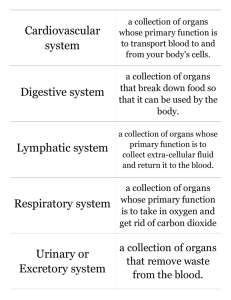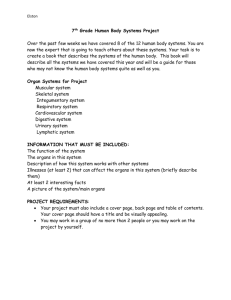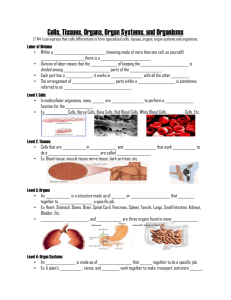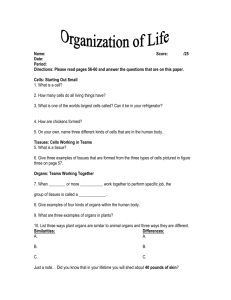Introduction to Zoology - Avon Community School Corporation
advertisement
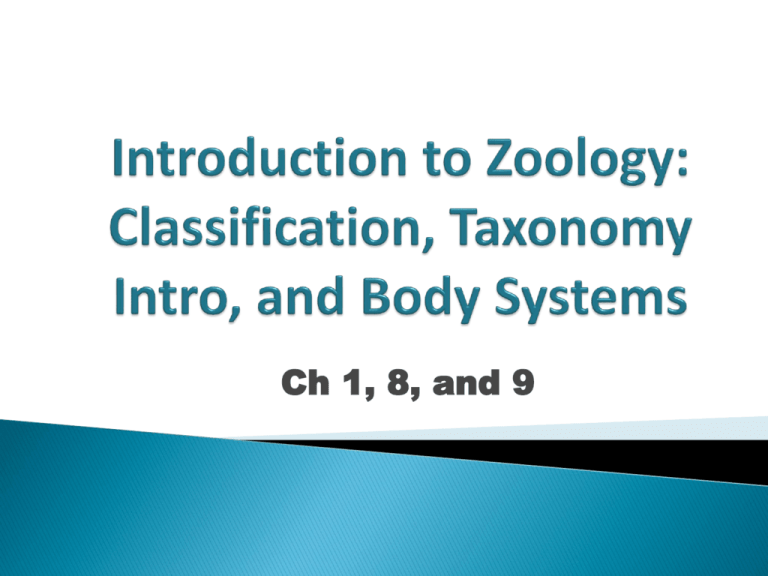
Ch 1, 8, and 9 Zoology is the study of animal life # of species currently classified: 1.5 million Use taxonomy to help classify animals ◦ What is taxonomy? Naming and evolutionary background of animals ◦ How? Using what? Use patterns of physical, chemical and ecological relationship to classify animals Use 5 categories to classify animals Definition ◦ Balanced proportions, how does size/shape Spherical compare on opposite halves 4 main types Biradial Bilateral Radial 1) Spherical ◦ Any plane passing through center divides body into equivalent parts/halves, very rare ◦ Ex: some unicellular organisms 2) Biradial ◦ Only two planes produce mirrored halves ◦ Ex: comb jelly fish 3) Radial ◦ More than two planes creates similar halves ◦ Ex: starfish, hydra, sponge 4) Bilateral ◦ Divides along a sagittal plant making right/left ½ ◦ Ex: most insects, mammals, birds, reptiles Evidence types ◦ 1) Fossils ◦ 2) Protein/DNA structure ◦ 3) Biochemistry (molecular make-up) ◦ 4) Biogeography Most widely used TODAY, in modern science to classify organisms Use phylogeny to group/classify organisms ◦ Def: origin and diversity of organisms ◦ Where did organisms come from? 10 major body systems 1) Circulatory ◦ Transports nutrients, gases (oxygen and carbon dioxide), hormones and wastes ◦ Organs: heart, veins, arteries, vessels, capillaries, blood 2) Digestive ◦ To breakdown food into proteins, vitamins, minerals, carbs and fats; absorbs nutrients necessary for growth and maintenance ◦ Organs: mouth, stomach, esophagus, intestines 3) Endocrine ◦ To rely chemical message throughout the body ◦ Organs: pituitary gland, thyroid gland, pancreas, liver, gall bladder, ovaries and testes 4) Lymphatic/Immune ◦ To destroy and remove invading microbes and viruses; remove fat and excess fluid ◦ Organs: lymph nodes, white blood cells, Tcells 5) Muscular system ◦ To provide movement, control movement of materials through some organs ◦ Three types of muscle tissue: skeletal, smooth, cardiac 6) Nervous system ◦ To relay electrical signals throughout the body, directs behavior and/or movement ◦ Organs: brain, spinal cord, nerves 7) Reproductive system ◦ To manufacture cells that allow for reproduction (sperm and egg) ◦ Organs: ovaries, vagina, uterus, mammary glands, fallopian tubes; testis, penis 8) Respiratory system ◦ To provide gas exchange between blood and the environment ◦ Organs: lungs, trachea, nose, bronchial tubes 9) Skeletal system ◦ To provide support for the body, protection of organs, provides attachment site for organs/muscles ◦ Organs: bones, cartilage, tendons, ligaments 10) Excretory/Urinary system ◦ To filter out cellular wastes, toxins and excess water from the circulatory system ◦ Organs: kidney, bladder, ureter Homologous is similarities between organisms resulting from a common ancestor This characteristic and evolutionary evidence work together Ex: Ecological: different biomes, different areas to eat, sleep, etc. ◦ Niche/Habitat Diet: What do they eat? Predator/Prey: ◦ Hunting for eating purposes Hierarchy From 1. 2. 3. 4. 5. 6. 7. largest group to smallest group Kingdom Phylum Class Order Family Genus Species How ◦5 many do we currently have? Names of these: ◦ Animal, plant, fungi, monerans/bacteria, protists Major differences between them: ◦ Fun/Animals: must consume food ◦ Plants: cell wall, chloroplasts ◦ Protists/monerans: unicellular 9 we study Annelida ◦ Names of each ◦ Example of each Echinodermata ◦ 8 invertebrates, 1 vertebrate ◦ Invert vs. vert. Platyhelminthes Nematoda Chordata Cnidaria Porifera Mollusca Arthropod Used in naming system called binomial nomenclature, current system of naming and classifying animals Scientist who invented system: Carl Linnaeus ◦ Genus – capitalized ◦ Species – NOT capitalized ◦ Both are italicized or underlined Ex: Homo sapiens How does phylogeny relate to classification and taxonomy ◦ Classification is categorizing ◦ Taxonomy is naming ◦ Phylogeny is using evolution to classify and name animals ◦ They are related because they all rely upon each other to get species organized into workable categories Species is a reproductive community living in a specific area/location 3 criteria for recognizing species 1) Common ancestor or common descent 2) Small grouping w/ distinct and unique characteristics 3) Must be able to reproduce ◦ After a NEW species is discovered: Must name it Classify it Use phylogeny (evolutionary evidence) 1) Comparative homology 2) Character variation 3) Ecological relationships


